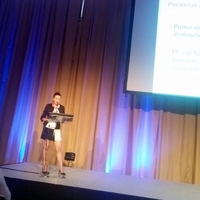Abstract The aim of the study was to define the prevalence of insomnia symptoms in rural regions and to determine the relationship between insomnia and the dysfunctional beliefs and attitudes about insomnia, and other risk factors. We... more
Abstract
The aim of the study was to define the prevalence of insomnia symptoms in rural regions and to determine the relationship between insomnia and the dysfunctional beliefs and attitudes about insomnia, and other risk factors. We used an own survey that included the Insomnia Severity Index and the Dysfunctional Beliefs and Attitudes about Sleep Scale. The study population was composed of individuals aged from 18 to 65 years from two rural areas. In total, 523 individuals were included in our study. Insomnia symptoms prevalence was determined as: 37.3 % subthreshold insomnia, 9.2% moderate severe insomnia and 0.4% severe insomnia. Significant risk factors for insomnia were having at least one of the problems of sleep walking, sleep talking and sleep bruxism (OR: 2.163 CI: 1.320-3.543) and dysfunctional beliefs and attitudes such as worrying about insomnia (OR: 1.068 CI: 1.037-1.100). According to the multiple regression analysis, the following are also determinants of insomnia score: the worry about insomnia (
β
=0.380) and the use of medication (
β
=0.098) dimensions of Dysfunctional Beliefs and Attitudes About Sleep Index, having at least one of the problems of sleep walking, sleep talking and sleep bruxism (
β
=0.131) and being obese or overweight (
β
=0.083).
Keywords
:
insomnia, dysfunctional beliefs and attitudes about sleep, risk factor, rural area
The aim of the study was to define the prevalence of insomnia symptoms in rural regions and to determine the relationship between insomnia and the dysfunctional beliefs and attitudes about insomnia, and other risk factors. We used an own survey that included the Insomnia Severity Index and the Dysfunctional Beliefs and Attitudes about Sleep Scale. The study population was composed of individuals aged from 18 to 65 years from two rural areas. In total, 523 individuals were included in our study. Insomnia symptoms prevalence was determined as: 37.3 % subthreshold insomnia, 9.2% moderate severe insomnia and 0.4% severe insomnia. Significant risk factors for insomnia were having at least one of the problems of sleep walking, sleep talking and sleep bruxism (OR: 2.163 CI: 1.320-3.543) and dysfunctional beliefs and attitudes such as worrying about insomnia (OR: 1.068 CI: 1.037-1.100). According to the multiple regression analysis, the following are also determinants of insomnia score: the worry about insomnia (
β
=0.380) and the use of medication (
β
=0.098) dimensions of Dysfunctional Beliefs and Attitudes About Sleep Index, having at least one of the problems of sleep walking, sleep talking and sleep bruxism (
β
=0.131) and being obese or overweight (
β
=0.083).
Keywords
:
insomnia, dysfunctional beliefs and attitudes about sleep, risk factor, rural area
Research Interests:
Abstract Objective: To assess the frequency of piercing and tattooing among university students and to determine the extent of risk-taking behaviour in this age group. Method: The descriptive cross-sectional study was conducted at a... more
Abstract
Objective: To assess the frequency of piercing and tattooing among university students and to determine the extent of risk-taking behaviour in this age group.
Method: The descriptive cross-sectional study was conducted at a university in Istanbul, Turkey, from December 2009 to February 2010. Data was obtained from students through a questionnaire. SPSS 20 was used for statistical analysis.
Result: Of the 1303 subjects, 838(64.3%) were girls. The overall mean age of the sample was 21.7±1.9 years. A total of 107 (8.2%) had piercings and 56(4.3%) had tattoos. It was seen that young people who had piercings and tattoos were significantly more likely (p<0.05) to exhibit certain types of risk behaviour including smoking, alcohol, substance abuse, extreme sports, carrying switchblades/knives, unprotected sexuality and having multiple sex partners.
Conclusion: In the face of the steadily increasing fads of piercing and tattooing among the youth, families, teachers and health professionals need to be constantly on the alert.
Keywords: Piercing, Tattooing, Risk behaviour. (JPMA 65: 587; 2015).
Objective: To assess the frequency of piercing and tattooing among university students and to determine the extent of risk-taking behaviour in this age group.
Method: The descriptive cross-sectional study was conducted at a university in Istanbul, Turkey, from December 2009 to February 2010. Data was obtained from students through a questionnaire. SPSS 20 was used for statistical analysis.
Result: Of the 1303 subjects, 838(64.3%) were girls. The overall mean age of the sample was 21.7±1.9 years. A total of 107 (8.2%) had piercings and 56(4.3%) had tattoos. It was seen that young people who had piercings and tattoos were significantly more likely (p<0.05) to exhibit certain types of risk behaviour including smoking, alcohol, substance abuse, extreme sports, carrying switchblades/knives, unprotected sexuality and having multiple sex partners.
Conclusion: In the face of the steadily increasing fads of piercing and tattooing among the youth, families, teachers and health professionals need to be constantly on the alert.
Keywords: Piercing, Tattooing, Risk behaviour. (JPMA 65: 587; 2015).
